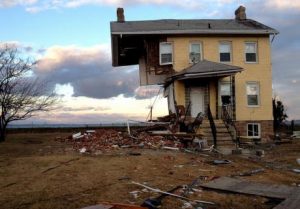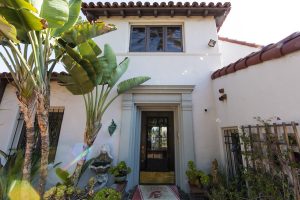
A California non-profit has made sustainable home construction easy and inexpensive!
Sustainability has grown in popularity in the last few years, encompassing virtually every industry. Builders have long wrestled with how to best incorporate sustainable features and materials into home construction. A non-profit based in Hesperia, California, has devoted its research to the construction of the sustainable homes designed by the California landscape.
The homes designed and built by CalEarth are not only built from natural, native materials, but they also incredibly easy and inexpensive to build. CalEarth "envisions a world in which every person in empowered to build a safe and sustainable home with their own hands, using the earth under their feet."
 The following is a first-person account was written by Kim Stringfellow for KCET.
The following is a first-person account was written by Kim Stringfellow for KCET.
The California Institute of Earth Architecture or Cal-Earth appears like some alien subdivision dropped out from space into one of those ubiquitous cookie-cutter suburban starter home communities in the urbanized southwestern Mojave Desert. To reach the Cal-Earth training/test site in Hesperia, one must first past through several streets of nearly identical homes with virtually the same SUV parked in front. When I looked for it, I felt lost amid these cookie cutter homes, but then suddenly, the Cal-Earth complex emerged with its array of exotic beehive-like adobe domes behind a chain-link fence. The juxtaposition of these strange structures against the backdrop of the recently-built suburban homes makes the Cal-Earth dwellings seem, at first glance, out of place, but after closer inspection they begin to appear completely natural in this arid environment. Then like a camera adjusting its focus, the generic tract homes surrounding them seem out of place with the desert.
At the gate, I was greeted by my friend, Hooman Fazly one of the long-term Cal-Earth associates who now travels the globe teaching Cal-Earth's Superadobe construction technique developed by its founder, Iranian-American architect, Nader Khalili. Hooman, who received his BA in architecture at UC Berkeley in 2003 and veered away from a successful career in conventional architecture. He took me on a tour of the various building experiments and prototypes found at the Cal-Earth training campus — some are built as low-cost, but reliable, emergency shelters for those affected by natural disasters. Others, such as the Earth One Vaulted tract home prototype exhibits how Khalili's building technique may be applied to more traditional contemporary homes found throughout SoCal suburbs.

Backside of the Earth One Vaulted Home Design. | Photo: Kim Stringfellow.
Hooman explains that Khalili founded Cal-Earth as a non-profit in 1991 with the philosophy that everyone deserves a sound shelter as a basic human right, that everyone should be able to build a house for him or herself and the best way to do so is using sustainable construction materials readily available such as earth.
As a humanitarian, architect and teacher, Khalili developed the Superadobe building technique incorporating a tubular sandbagging system filled with locally sourced earth that are reinforced with a barbed wire technology and stabilized lime, cement, or asphalt that is locally produced. Dwellings can be used temporarily or may be stabilized, waterproofed, and finished with plaster to create a permanent building. Originally from Iran, Khalili's structures and building techniques are inspired and informed by centuries of earth building found throughout the Middle East and North Africa. He also is known for his Geltaftan Earth-and-Fire construction system which as also known as Ceramic Houses. Khalili has presented his architectural ideas to N.A.S.A. as possible lunar shelters and was received awards for his projects from the United Nations.

Photo: Kim Stringfellow.
Cal-Earth's coiled Superadobe forms arches, domes, vaults, and apses using local materials are easy and cheap to come by. Overall construction of Superadobe is inexpensive, affordable, and sustainable to build. Construction techniques may be taught to local laborers in a matter of days providing them with supplemental labor skills. Aesthetically the dome structures are not only beautiful to view but are also incredibly strong, fire resistant, and heavily insulated from the elements due to the Superadobe construction. Cal-Earth sandbag structures have passed California's rigorous seismic building codes making them stable during an earthquake. Apprentices and associates from Cal-Earth have trained and overseen the building of a variety of Cal-Earth structures on nearly every continent.
Indeed, it seems that Hooman is more than often traveling the world than at his home base in nearby Apple Valley training others in the Superadobe construction technique developed by Cal-Earth. One such project that he has participated in with other Cal-Earth associates in the Tribewanted Sierra Leone eco-community at John Obey Beach. Tribewanted formed a partnership with the Sierra Leone government, landowners and the local John Obey community to build this sustainable eco-resort whose profits will "be re-invested in the local John Obey community, in education and microfinance through Shine On Sierra Leone."
Kushe O John Obey Beach from Tribewanted on Vimeo.
A wonderful example of how Khalili's earth architecture techniques can be applied to commercial architecture may be seen at the Gunoot Eco Resort located on 30 km undeveloped beachfront near the remote fishing village of Shuwaimia in southern Oman. This project won the first prize for the "Future Projects — Leisure" category at the World Architecture Festival in 2012. Gunoot developers chose Kuwait's SSH International principal architect Waleed Shaalan's proposal to construct a sustainably-built eco retreat based on Khalili's construction techniques developed at CalEarth using locally sourced construction materials, including old fishing nets instead of the typical costly high-rise resort architecture. Green architectural design would encourage eco tourists to travel to the area who were seeking a unique, sustainable vacation alternative to the ubiquitous resort hotel experience found at more high-density destinations along the Gulf. Solar technologies providing electricity, hot water, and cooling are incorporated into the design infrastructure and have reduced energy consumption overall by 30 to 40 percent. Local stone was used for the interior flooring.

Photo: Waleed Shaalan, SSH International.
During the initial construction phase resident fisherman and other workers from the surrounding community were trained during a 5-day training headed by Cal-Earth and built a prototype structure on site. This hands-on training in super adobe construction provided the workers with additional labor construction skills that they could rely on after seasonal fishing was over. The Gunoot project refers and suggests the regional culture in its design providing a sense of pride and identity for the local community — interior of the resort are decorated with local art and crafts objects and textiles. The final master plan for the project includes the construction of a permanent crafts center that would provide opportunities for local woman and would continue to provide onsite training in sustainable building techniques for the local university architecture students.

Photo: Waleed Shaalan, SSH International.

Photo: Kim Stringfellow.
The Cal-Earth facility in Hesperia provides educational materials and workshops for those interested in learning their Superadobe or permaculture techniques for a modest fee. Open house dates that include a potluck lunch are available at the Cal-Earth website.
Address of Cal-Earth Institute Site:
10177 Baldy Lane, Hesperia, CA 92345
Follow the blue and white Hesperia City Cal-Earth Institute direction signs: Hesperia Main Street exit from the 15, to Topaz Avenue north, left on Live Oak Street, right on Baldy Lane.





0 Responses
Khalili is a very inspired architect. Basicaly he used a millenias-old architectural wisdom from the Middle east and combined it with modern day materials. This kind of housing if both cheap and energy effective insulating the inside of a house from the outside.
His company is giving a very good solution to building affordable houses in desert-like locations that are under extreme heat in the summer (just like Arizona), where any modern house would need to expend lots of electricity in air-conditioning.
Note that he also uses a dome shape and arched ceilings instead of straight lines, that’s because arches and domes are much more resilient in earthquakes than cubical or cylindrical structures.
To me they seem like a “Star Wars”-landscape, just like those houses on the desert planet where Anaking came from. Especially those last two pictures. (There’s many people who are in love with this architectural style because of Star Wars)
Yeah, it looks like a house inspired by Star Wars movies. The design can withstand earthquake and other disaster. Its wonderful to see this kind of houses be available for anyone who like to live in a earth-friendly house.
I am just glad to see that these are out there and that people are thinking the correct way. Of course it will be a long long time before anything like this goes large scale, but small steps first is always the way to go.
That’s true my friends, take the first step and the second one will be easier to take, that’s how everything runs.
Yea, this kind of houses have a long way to be commercialized because of the modern houses now is such a large scale and expensive like houses built to look elegant. This design is more efficient and inexpensive to acquire and to live in.
Wow! I only see this kind of houses out of a sci-fi movies. Its design has functions that is why the house looks different. As you said, the other normal houses in that desert like area looked out of place when you stayed a little longer seeing many kinds of these sustainable earth homes all in one place.